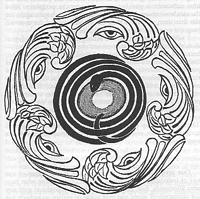a feminine vision
I've started reading Dan Brown's The Da Vinci Code and come across the pentacle as a basic and ancient goddess symbol. It occurred to me that Jung, despite his tentative steps toward encouraging the return of feminine deity, was nevertheless a man of his time and definitely not tuned in to the 5-fold form. He took quite a patronising stance to pentadic mandalas, describing them as "disturbed" totality pictures (para 646, CW9/I, Concerning Mandala Symbolism). Below is a 5-fold mandala that has plenty of numinous quality for me, as if an ancient goddess is watching a process of new beginnings for feminine consciousness. It was made by an older woman patient of Jung's (old enough to be a crone or Wise Old Woman) but his commentary below borders on the dismissive.

Mandala by a woman patient
Aged 58, artistic and technically accomplished. In the centre is the egg encircled by the snake; outside, apotropaic wings and eyes. The mandala is exceptional in that it has a pentadic structure. (The patient also produced triadic mandalas. She was fond of playing with forms irrespective of their meaning - a consequence of her artistic gift.)
from C.G. Jung: A Study in the Process of Individuation
in The Archetypes and the Collective Unconscious
Jung's 4-fold, 8-fold and 12-fold mandalas seem rigid and static in comparison while the 3-fold, 5-fold and 7-fold mandalas seem better to reflect the mysteries of nature which has no problem at all producing them (especially the 5-fold in flowers and starfish) while man with his compass alone simply cannot manage. The odd-numbered symmetric forms have always been a puzzle to the mathematicians but not to nature. And women have always been associated both with nature and with cyclic rhythms (especially birth-death-rebirth) in contrast to more stable and static forms linked to men. I suspect that women have been dismissed, disregarded, distanced and disowned precisely because of this association with life-and-death. We crave immortality and permanence and masculine phallic symbols seem to represent those things for us.
Funny really. The male organ spends so much more time dangling pathetically with nothing to say for itself but a kind of world-weariness.
The rose has a thorn
And punishment in store.
What have I done
To deserve this scorn?



0 Comments:
Post a Comment
<< Home